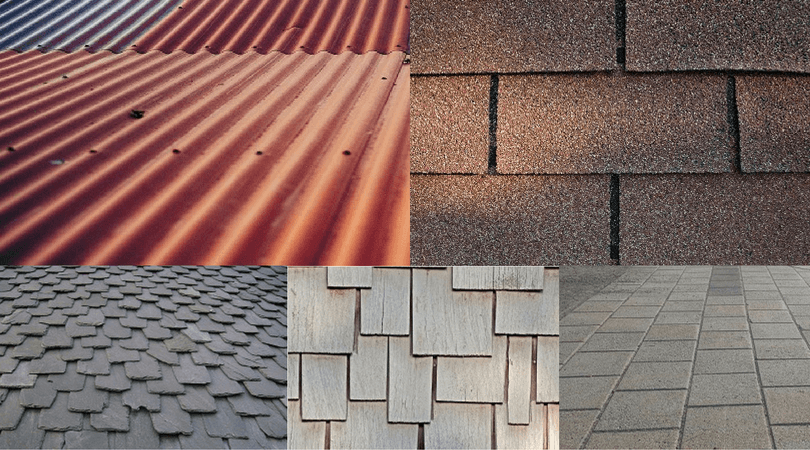


When selecting the right roofing material for your home, there is a lot to consider. Your roof plays an important role in protecting your home from the natural elements, and it also increases the value of your home depending on its insulation quality and appearance.
What all started with just banana leaves and hay stacks to prepare a shelter from the rain and sun has now emerged as an industry with an extensive range of products. Roofers now offer materials and styles like natural slate and wood to manufactured products such as asphalt, sheet metal, and plastic polymers.
Studies show that more than 75% of Americans choose this roofing material because of its low cost, easy installation, and resiliency. These are made of fiberglass mat, which is saturated with asphalt and coated with colored mineral granules.
They have low insulation quality and a shorter life span than any other roofing material. Standard shingles are available in a wide variety of colors and are the cheapest option for roofing material.
Metal roofing was used for warehouse construction in the past, but with advanced technological changes, many people choose metal roofing for their residential homes. They are available in copper, aluminum, and stainless steel with a high percentage of recycled content.
The look varies from traditional metal roof panels to simulating wood shakes and shingles, slate, or tile. Metal roofing is lightweight, fire-resistant, and durable. Besides its longevity, it is much lighter than most materials and resistant to adverse weather.
Wood shingles and shakes are available in different qualities of wood, like cedar, redwood, and southern pine. Shingles are made with the help of a machine, whereas shakes are handmade and have a rougher look. Since this type of roofing is more aesthetically appealing due to its natural appearance, it's much more expensive than asphalts.
However, in recent years, its use has been a concern due to its lack of fire resistance and the potential of mold in heavy rainfall.
These shingles and shakes have been categorized under class 'A' and 'B' according to the specified character. Class 'B' products have been pressure treated with fire retardants and are readily available.
Before considering a wood roof, please check with your local building departments that there aren't any restrictions in your community.
Clay tile is made from natural clay fired in a kiln, whereas concrete tile is made from a mixture of Portland cement and sand. These tiles give comparable benefits to slate but with a greater variety and lower cost. Tile is very durable and fire resistant but much heavier andmore expensive than other materials like asphalt, shingles, and fiber cement products, so your roof may require reinforcement if you are planning to go for tile roofing.
Slate is a dense natural material that is non-absorbent. Its color is determined by its chemical and mineral compositions. As we know, these factors vary from place to place; slate is available in various colors. These factors also influence the responsiveness of slate towards changing color upon exposure to weather.
Those with minimum change in color are known as "permanent" slates, while those with the most color changes are known as "weathering" slates.
Re-roofing with slate will require roof reinforcement to carry its heavy load. Although it's non-leaching, lasts for hundreds of years, and its natural beauty is unparalleled, it is one of the most expensive steep slope roofing materials. Its installation is labor-intensive and requires considerable skills.
See Also: Top Reasons Why You Should Consider Spray Foam for Your Commercial Roof
Silicone roof coating restoration is one of the most affordable, cost-effective, and durable options if you are looking for roof restoration or a new roof coating. Silicone roof coating is made up of 100% silicone which helps to prevent leaks more efficiently than any other roofing material. This roof coating doesn't require a primer and double coating. Hence it'll save you time, material costs, and labor charges.
Applied Roofing Services, based in Orange County, CA, is the best place for all your roofing requirements if you are looking for roof restoration or a new roofing system.
Here are some commonly asked questions about roof types in California:
Leaking roofs with wet ceilings and missing or damaged shingles that warn of potential leaks are signs of urgent roof replacement.
Clay tiles, metal roofing, and fiberglass asphalt shingles are all appropriate roofing choices for high-wind areas.
The longest-lasting roof materials are the clay, concrete, and slate, lasting more than 100 years, followed by metal roofing that may last up to 80 years.
Metal, slate, clay, and rubber are four excellent roofing options for a hot climate- slate is the most expensive, and rubber is the cheapest.
Solar glass roofing is the most durable of all roof types. Though considerably expensive, it can last more than 100 years and is incredibly energy efficient.
Asphalt roofing is the most affordable, with asphalt shingle prices ranging from $70 to $160 per square foot.
See Also: Silicone Roof Coating: What Should You Know About It
Roofs with multiple slopes, ideally inclined at 30 degrees, are the best to stand against extreme wind pressure. Hence, the 4-sloped hip roof is safer than a gable roof with just two slopes.